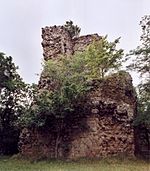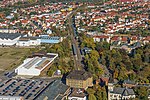Teufelsmauer

The Teufelsmauer (Devil's Wall) is a rock formation made of hard sandstones of the Upper Cretaceous in the northern part of the Harz Foreland in central Germany. This wall of rock runs from Blankenburg (Harz) via Weddersleben and Rieder to Ballenstedt. The most prominent individual rocks of the Teufelsmauer have their own names. The Teufelsmauer near Weddersleben is also called the Adlersklippen ("Eagle Crags"). Many legends and myths have been woven in order to try to explain the unusual rock formation. It was placed under protection as early as 1833 and, in 1852, by the head of the district authority in order to prevent quarrying of the much sought-after sandstone. The Teufelsmauer near Weddersleben has been protected since 1935 as a nature reserve and is thus one of the oldest nature reserves in Germany.
Excerpt from the Wikipedia article Teufelsmauer (License: CC BY-SA 3.0, Authors, Images).Teufelsmauer
Teufelsmauerstieg,
Geographical coordinates (GPS) Address Nearby Places Show on map
Geographical coordinates (GPS)
| Latitude | Longitude |
|---|---|
| N 51.7575 ° | E 11.083055555556 ° |
Address
Teufelsmauerstieg
Teufelsmauerstieg
06502 (Weddersleben)
Saxony-Anhalt, Germany
Open on Google Maps



